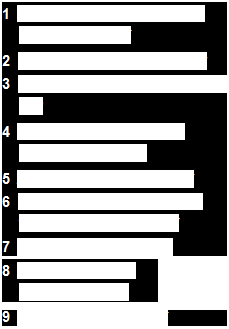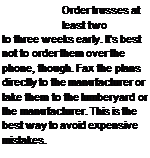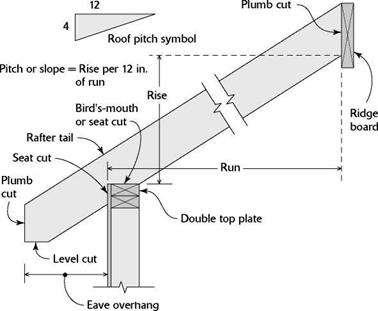SHELTER
The walls for our house are up and we now have something to show for our work. At this stage, we can walk through the structure; admire the view through rough window openings; and imagine how the finished siding, painted drywall, and flooring will look. But first, we need to raise the roof.
Before we reach for a hammer, we need to make some decisions about the roof trusses. We also have to prepare the site for their delivery and do some layout work so that the installation process can go smoothly. Once the trusses are installed, we’ll move on to the fascia boards, sheathing, and shingling.
Early in my building career, I was taught how to lay out rafters with a site-made template containing the plumb and bird’s-mouth cuts. You can still cut and frame a roof one rafter at a time (see the illustration on p. 114), but today most roofs are constructed with factory-made trusses. Trusses are designed on a computer, built on an assembly line, and delivered to the job site ready to install. If you’re building a simple gable-roof house like the one shown here, roof trusses can save time and keep the construction process simple—something that everyone will appreciate.

 Each truss includes a pair of rafters and a bottom chord that functions as a ceiling joist inside the house and as level soffit framing outside the house. Short lengths of wood, called webbing, connect the rafters with the bottom chord; barbed steel gusset plates (gussets, for short) are pressed into place over the joints to hold all the parts together. For a basic look at the different truss configurations, see the illustrations on p. 115. The basic roof installation process that we’ll use on this house will be very much the same for other houses, regardless of size.
Each truss includes a pair of rafters and a bottom chord that functions as a ceiling joist inside the house and as level soffit framing outside the house. Short lengths of wood, called webbing, connect the rafters with the bottom chord; barbed steel gusset plates (gussets, for short) are pressed into place over the joints to hold all the parts together. For a basic look at the different truss configurations, see the illustrations on p. 115. The basic roof installation process that we’ll use on this house will be very much the same for other houses, regardless of size.

![]()

![]()
![]()

On the house we’re building, the main roof extends over a small porch. In this situation, you need to have at least some of the porch framed before installing the roof trusses. Some builders choose to erect temporary posts to support the top beams on which the roof trusses (or rafters) will bear. When the porch is completed later, these temporary posts are replaced with permanent ones. This strategy allows roof framing to follow wall framing directly, without the interruption of porch construction work. For details on how to build a porch or a deck that’s attached to the house, see Chapter 7.
After you make a few basic decisions about the trusses for your house, it’s fairly easy to order them. I like the raised-heel design of the trusses we used on this house (see the top illustration on the facing page). This type of truss
provides an overhang along the eave walls as well as framing for a level soffit. Because the rafter is elevated above the wall’s top plate, there’s ample room for ceiling insulation and ventilation space above.
However, as shown in the illustration on the facing page, other truss designs are also possible. Depending on your budget and design preferences, you can use a scissor-type truss and have a cathedral ceiling inside the house. Or perhaps you like the rustic appearance of an open soffit and exposed rafter tails along the eaves. A good lumber dealer has different truss designs to show you, and it’s worth taking a look. Once you decide, here are the basic specifications the manufacturer needs to design and construct your trusses:
TYPE OF TRUSS. The major types of trusses for gable roofs are shown in the illustrations on the facing page.
SPAN BETWEEN EXTERIOR WALLS. The
span is measured from one outside edge of the building to the other.
EAVE DETAILS. The amount of overhang at a building’s eaves is usually shown on the plans. The plans should also tell you whether the soffit will






Leave a reply